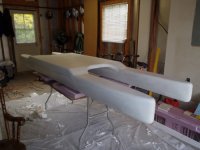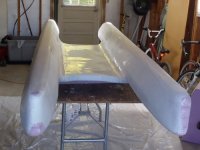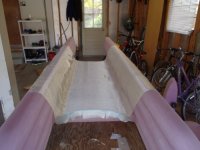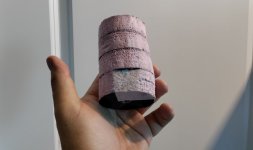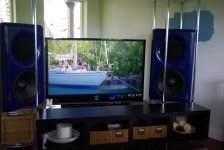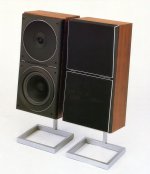In the past couple of years, I've spent a lot of times reflecting on the measurements performed by Erin at erinsaudiocorner and Amir at AudioScienceReview. In particular, that the shape of an enclosure has a big impact on directivity. Basically, as sound diffracts around the baffle of an enclosure, it reduces how much sound is radiated to the top, bottom, left and right of the loudspeaker.
See: https://www.diyaudio.com/community/threads/what-do-roundovers-do.303155/ and https://www.diyaudio.com/community/threads/the-preference-for-direct-radiators.330741/
Inspired by that, I made an XPS foam "stand" for my bookshelf speakers in my office. Up until now, my speakers sat on a speaker stand similar to the attached pic.
The XPS foam "stand" is basically four foam cylinders, each cylinder measuring 10cm tall by 7.62cm in diameter.

I wasn't expecting it to make much of a difference, but I was curious if it would be worthwhile to eliminate the surface below the speaker. In the measurements performed by Erin and Amir, we can see that the space that surrounds the speaker makes a big difference on the speaker performance. And when you put speakers on a stand, that's not 100% ideal, because the stand itself impacts the sound.
Again, I wasn't expecting much of a difference, and I nearly gave up on this little project because it was time consuming and made a big mess. (I had to cut sixteen pieces of foam, creating an absolute mess of XPS foam dust.)
But, lo and behold, the imaging of the speaker is noticeably better. I really wasn't expecting much, in fact I didn't even listen to it after I finished the project, because I didn't think that improving things on one side of the speaker would do much. But I turned on my usual podcasts this morning, and the sound of the center channel sounds:
1) more solid.
2) It's bizarre how the speakers don't even sound like they're there. It's really strange, it's like the sound isn't coming from the speakers.
3) The soundstage is deeper.
And I didn't move the speakers at all (except that they're 4" higher now, because of the foam stand.)
Of course, this begs the question:
Does it sound better because it's elevated above the stand, creating more "space" around the speaker?
Or does it sound better because the XPS foam is damping vibrations that would normally get transmitted into the stand?
Or both?
I've rarely used spikes on my subwoofers or speakers because I don't want to screw up my floors. Plus, spikes always seemed a little "tweaky" to me and I figured they were probably about as important as fancy loudspeaker interconnects.
But I have a hunch that the improvement in the imaging is probably due to combination of creating more space around the speaker and isolating it.
Back in the day, Geddes mentioned off hand that one way to isolate subwoofers is to suspend them. Basically put some hooks in the top of the sub and hang them from bungie cords, so that they don't radiate energy into the floor.

This little experiment definitely has me thinking that might be a good idea. Since the speakers are in my office, I don't really need to worry about WAF. Perhaps figure out where the studs are located in the ceiling, and then suspend the speakers from the ceiling itself, similar to how you'd hang a plant.
See: https://www.diyaudio.com/community/threads/what-do-roundovers-do.303155/ and https://www.diyaudio.com/community/threads/the-preference-for-direct-radiators.330741/
Inspired by that, I made an XPS foam "stand" for my bookshelf speakers in my office. Up until now, my speakers sat on a speaker stand similar to the attached pic.
The XPS foam "stand" is basically four foam cylinders, each cylinder measuring 10cm tall by 7.62cm in diameter.

I wasn't expecting it to make much of a difference, but I was curious if it would be worthwhile to eliminate the surface below the speaker. In the measurements performed by Erin and Amir, we can see that the space that surrounds the speaker makes a big difference on the speaker performance. And when you put speakers on a stand, that's not 100% ideal, because the stand itself impacts the sound.
Again, I wasn't expecting much of a difference, and I nearly gave up on this little project because it was time consuming and made a big mess. (I had to cut sixteen pieces of foam, creating an absolute mess of XPS foam dust.)
But, lo and behold, the imaging of the speaker is noticeably better. I really wasn't expecting much, in fact I didn't even listen to it after I finished the project, because I didn't think that improving things on one side of the speaker would do much. But I turned on my usual podcasts this morning, and the sound of the center channel sounds:
1) more solid.
2) It's bizarre how the speakers don't even sound like they're there. It's really strange, it's like the sound isn't coming from the speakers.
3) The soundstage is deeper.
And I didn't move the speakers at all (except that they're 4" higher now, because of the foam stand.)
Of course, this begs the question:
Does it sound better because it's elevated above the stand, creating more "space" around the speaker?
Or does it sound better because the XPS foam is damping vibrations that would normally get transmitted into the stand?
Or both?
I've rarely used spikes on my subwoofers or speakers because I don't want to screw up my floors. Plus, spikes always seemed a little "tweaky" to me and I figured they were probably about as important as fancy loudspeaker interconnects.
But I have a hunch that the improvement in the imaging is probably due to combination of creating more space around the speaker and isolating it.
Back in the day, Geddes mentioned off hand that one way to isolate subwoofers is to suspend them. Basically put some hooks in the top of the sub and hang them from bungie cords, so that they don't radiate energy into the floor.

This little experiment definitely has me thinking that might be a good idea. Since the speakers are in my office, I don't really need to worry about WAF. Perhaps figure out where the studs are located in the ceiling, and then suspend the speakers from the ceiling itself, similar to how you'd hang a plant.
By
Seems like you got worthwhile results. Would you be interested in moving the speakers up 4” with something else to check how much the position change is part of the new sound? Maybe with wood or pvc pipe?
By this I take it to mean Expanded Polyethylene Foam. Often called styrofoam in North American? Just to be clear what you are using.I made an XPS foam "stand"
Seems like you got worthwhile results. Would you be interested in moving the speakers up 4” with something else to check how much the position change is part of the new sound? Maybe with wood or pvc pipe?
XPS foam is sold as "foamular" at Home Depot.
It's probably my favorite material for mocking up things quickly. It's significantly denser than what is sold as styrofoam. Both are sold as insulation at Home Depot, but Foamular is much denser.
Because of the higher density, it's easier to cut, sand, etc.
I use it for just about everything. If you make something out of Foamular and the project turns out well, you can add a couple layers of wood, fiberglass (or both) and it's basically as strong as plywood but much more rigid.
Attached are some pics of a boat made out of Foamular; it's crazy useful stuff.
It's probably my favorite material for mocking up things quickly. It's significantly denser than what is sold as styrofoam. Both are sold as insulation at Home Depot, but Foamular is much denser.
Because of the higher density, it's easier to cut, sand, etc.
I use it for just about everything. If you make something out of Foamular and the project turns out well, you can add a couple layers of wood, fiberglass (or both) and it's basically as strong as plywood but much more rigid.
Attached are some pics of a boat made out of Foamular; it's crazy useful stuff.
Attachments
Can you please post a pic or two of your new stands?
May some specifics of how they are made?
Cheap tweaks with material from HD is right up my alley.
Thanks
Randy
May some specifics of how they are made?
Cheap tweaks with material from HD is right up my alley.
Thanks
Randy
It's just four cylinders of XPS foam (see attached)
When I went and took the photo for you (five minutes ago) I found that half of the foam cylinders weren't even touching the speaker.
Basically, I made the cylinders out of two different sheets of XPS foam, and it appears that half of them were about 5% thinner than the others.
Due to the difference in diameter, half of the cylinders weren't even touching the speaker; the speaker was resting on just two of the four cylinders.
I'm in a meeting right now, but should be interesting to see if fixing that made a difference. If so, it would indicate that isolating the speakers was The Secret Sauce.
When I went and took the photo for you (five minutes ago) I found that half of the foam cylinders weren't even touching the speaker.
Basically, I made the cylinders out of two different sheets of XPS foam, and it appears that half of them were about 5% thinner than the others.
Due to the difference in diameter, half of the cylinders weren't even touching the speaker; the speaker was resting on just two of the four cylinders.
I'm in a meeting right now, but should be interesting to see if fixing that made a difference. If so, it would indicate that isolating the speakers was The Secret Sauce.
Attachments
for nearfield listening I would expect 4" to have a significant difference in frequency response, similar to being at couch distance and standing up?
I need to dig up the pictures, but back in the day, I had my Gedlee Summas on one of those wire shelves that you get from Target or Home Depot.
I didn't do that to make the Summas sound better, I just had these big ol' speakers that were heavy, and nothing to place them on. Obviously a conventional speaker stand wasn't sufficient because of the size and the weight of the Summa.
I didn't give it much thought at the time, but I found that the Summas had a way of "disappearing" that belied their size. Perhaps that shelf was part of it.
I didn't do that to make the Summas sound better, I just had these big ol' speakers that were heavy, and nothing to place them on. Obviously a conventional speaker stand wasn't sufficient because of the size and the weight of the Summa.
I didn't give it much thought at the time, but I found that the Summas had a way of "disappearing" that belied their size. Perhaps that shelf was part of it.
Found a pic.
This was my hapless attempt to try and integrate a pair of HUMONGOUS speakers into my living room decor lol
I basically had them on wire stands and they were tucked into a corner.
Due to the huge size, it was really difficult to get them away from the walls or nearby reflections.
For a while, I had the Summas on the same wire shelves, but located in my basement, with no TV or nearby reflections. I basically had a desk setup where the Summas were about two meters away from the desk, with nothing located nearby. And they "disappeared" when listening.
This was my hapless attempt to try and integrate a pair of HUMONGOUS speakers into my living room decor lol
I basically had them on wire stands and they were tucked into a corner.
Due to the huge size, it was really difficult to get them away from the walls or nearby reflections.
For a while, I had the Summas on the same wire shelves, but located in my basement, with no TV or nearby reflections. I basically had a desk setup where the Summas were about two meters away from the desk, with nothing located nearby. And they "disappeared" when listening.
Attachments
Link for the foam from HD
In stock at my local store.
Wondering why not make a square/rectangle shape instead of circle? Guessing would make cutting out easier.
Also wondering how big your circles are? Although I think it would be based on how big your speakers are.
Randy
In stock at my local store.
Wondering why not make a square/rectangle shape instead of circle? Guessing would make cutting out easier.
Also wondering how big your circles are? Although I think it would be based on how big your speakers are.
Randy
Diffraction and wave propagation around a larger baffle has a huge impact on imaging, overall midrange FR, especially in a heavily treated room ie there's a greater contrast between direct and reflected sound. One of the reasons I prefer soffit mounted monitors.
Do have a link to those feet?I went from poor man's spikes:
View attachment 1099089
To industrial damping feet:
View attachment 1099090
Those feet were much better performers to isolate the speakers. I've used them on my subwoofers too.
View attachment 1099091
I'm in The Netherlands, so it might not help you much,
I just sourced them from firms like this: https://www.ammertech.nl/merken/martin-levelling/ I'd have to look up which ones I've used in the past.
I just sourced them from firms like this: https://www.ammertech.nl/merken/martin-levelling/ I'd have to look up which ones I've used in the past.
The only results I got from speaker stands was when I made a pair out of a sand filled clay chimney pipe with a paver base and concrete cap. The speaker was set upon 3 ball bearings held in brass cups, set in the concrete cap. They weighed ~100 lbs each and I couldnt move them without a hand truck. Setting my Dalhquist M-905s atop those definitely decoupled them from the floor; they did sound as if they were isolated within the room.
I bought a set of two bicycle hanging fixtures for $10 at a yard sale, which I'm going to attempt to use in the garage for hanging speakers from the rafters; being rope based it should isolate them. And allow me to swap cabinets easier than hauling them up there on a ladder; holding the cabinet while struggling to get a first lash fixed around the beam; which just isnt possible for a couple pairs I have. Of course, in order to use this, the speaker would have to be fixed to accept the hook in a way that wont come off!
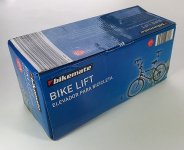
I bought a set of two bicycle hanging fixtures for $10 at a yard sale, which I'm going to attempt to use in the garage for hanging speakers from the rafters; being rope based it should isolate them. And allow me to swap cabinets easier than hauling them up there on a ladder; holding the cabinet while struggling to get a first lash fixed around the beam; which just isnt possible for a couple pairs I have. Of course, in order to use this, the speaker would have to be fixed to accept the hook in a way that wont come off!

The first time I heard Jon Whitledge's "Magic Bus", he put on "Billie Jean" by Michael Jackson. The song begins with a bassline by Louis Johnson:
https://en.wikipedia.org/wiki/Billie_Jean#Production
Listening to the track in his bus, my first thought was "I wonder who did this cover?"
It wasn't until the lyrics came into the song, that I realized I was listening to the original. Basically the bass sounded so much cleaner than I'd ever heard, that I'd assumed Jon was playing a remake or a cover of the song.
Jon went kinda crazy with both:
1) isolating the subwoofers
2) and absorbing any sound radiated by the subwoofers
So it almost sounds like you're listening to a stereo that's not even in a room or a vehicle. The bass is extremely "dry" there's basically little or no contribution from the vehicle where the subs are mounted in. The subs are isolated like this:

Some type of neoprene isolation mechanism. Jon has a degree on mechanical engineering and this stuff is way over my head: https://www.magicbus.biz/products.html
https://en.wikipedia.org/wiki/Billie_Jean#Production
Listening to the track in his bus, my first thought was "I wonder who did this cover?"
It wasn't until the lyrics came into the song, that I realized I was listening to the original. Basically the bass sounded so much cleaner than I'd ever heard, that I'd assumed Jon was playing a remake or a cover of the song.
Jon went kinda crazy with both:
1) isolating the subwoofers
2) and absorbing any sound radiated by the subwoofers
So it almost sounds like you're listening to a stereo that's not even in a room or a vehicle. The bass is extremely "dry" there's basically little or no contribution from the vehicle where the subs are mounted in. The subs are isolated like this:

Some type of neoprene isolation mechanism. Jon has a degree on mechanical engineering and this stuff is way over my head: https://www.magicbus.biz/products.html
Going back 50 years we used the "New" plastic milk crates as speaker stands, aren't the best speaker stands those with the minimum amount of material in them rather than simple boxes made from flat sheets of stuff that reflect?
I just need to clarify what you did (apologies, I'm getting old and, apparently, a bit slow). The small pucks of foam you are holding are what you placed beneath the speakers? What was their combined height, and were they only at the corners, or did they form a perimeter of foam pucks?It's just four cylinders of XPS foam (see attached)
When I went and took the photo for you (five minutes ago) I found that half of the foam cylinders weren't even touching the speaker.
Basically, I made the cylinders out of two different sheets of XPS foam, and it appears that half of them were about 5% thinner than the others.
Due to the difference in diameter, half of the cylinders weren't even touching the speaker; the speaker was resting on just two of the four cylinders.
I'm in a meeting right now, but should be interesting to see if fixing that made a difference. If so, it would indicate that isolating the speakers was The Secret Sauce.
...aren't the best speaker stands those with the minimum amount of material in them?
Like the attached BeoVox stands?
Attachments
I just need to clarify what you did (apologies, I'm getting old and, apparently, a bit slow). The small pucks of foam you are holding are what you placed beneath the speakers? What was their combined height, and were they only at the corners, or did they form a perimeter of foam pucks?
Yes, I used the foam blocks to elevate the speaker by four inches. My logic was that the sound is radiated by the loudsepaker, and if the sound diffracts around the enclosure, that reduces how much energy is radiated off-axis.
The less energy that's radiated off axis, the less the speaker interacts with the room.
I measure a lot of speakers, and when a speaker is within a meter of any object, the difference in the measurement is unmistakable.
If one could figure out how to put about a meter of space around the loudspeaker, that would probably help a lot.
It's funny, I am typing this post in my living room right now. And the speakers in my living room aren't on stands at all; they're just sitting on my entertainment center and my subwoofers.
And now that I've heard what a difference it makes to get the speakers in my office just four inches away from their stands, it's really got me wondering what things would sound like if I could get them a foot or even a meter away.
Here's a subjective description of the difference:
The speakers in my office have a really nicely defined center image, and the overall image is diffuse, not pinpoint. I don't have a center channel in my office. Getting the speakers off the stands (by just four inches) made it seem like the sound isn't really radiating from the speaker any longer.
The speakers in my living room have a center channel, and the sound is basically "anchored" to the speaker itself.
One big difference here, and I hope it's not a major factor, is that the amp in office is single ended Class A and the amp in my living room is Class D. I imagine that it would be ideal to swap the amps between office and living room and see what the amplifier's contribution is. I'm no expert on amps, but I imagine that it might be possible that the Class A amp is more "sensitive" to tweaks in the system.
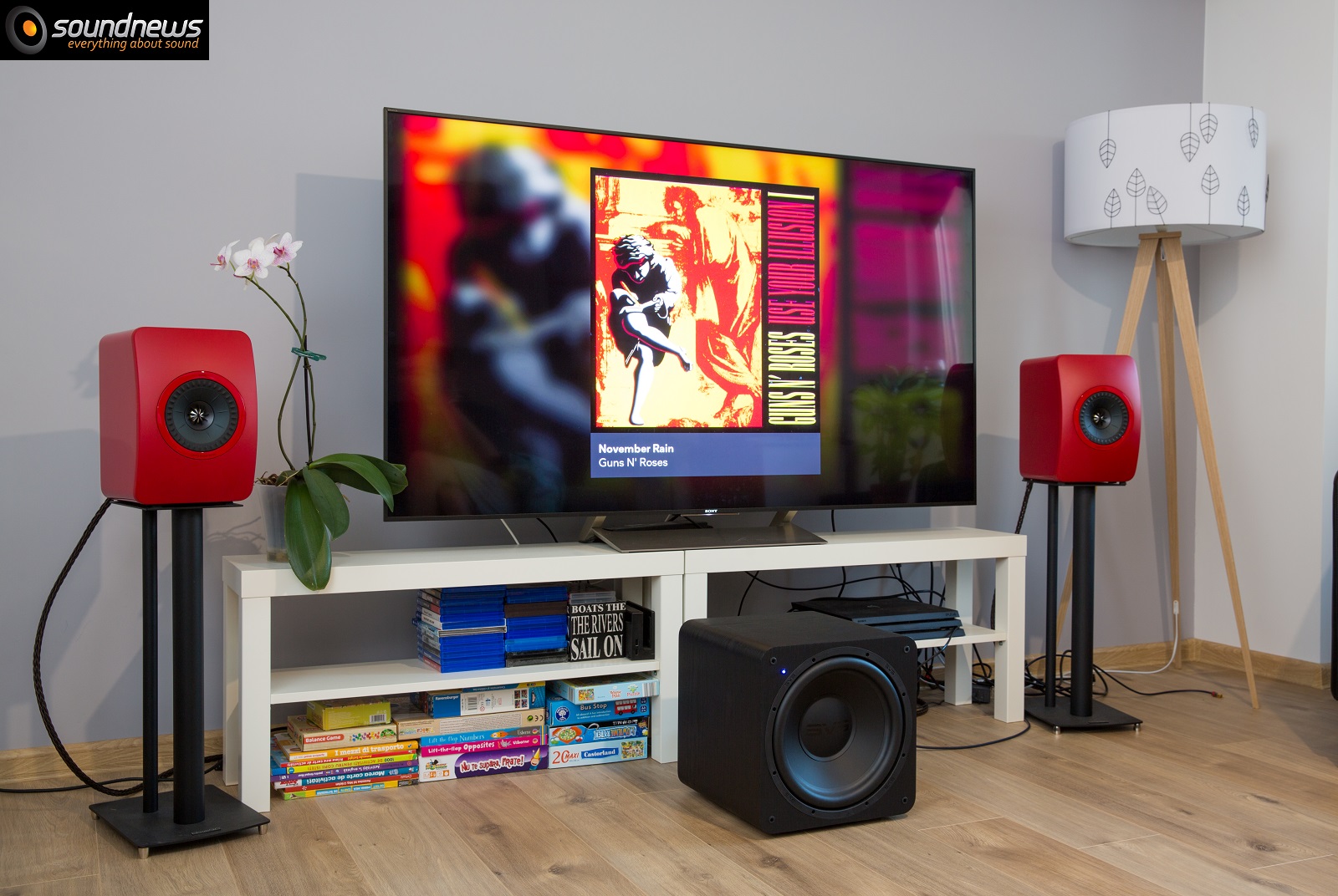
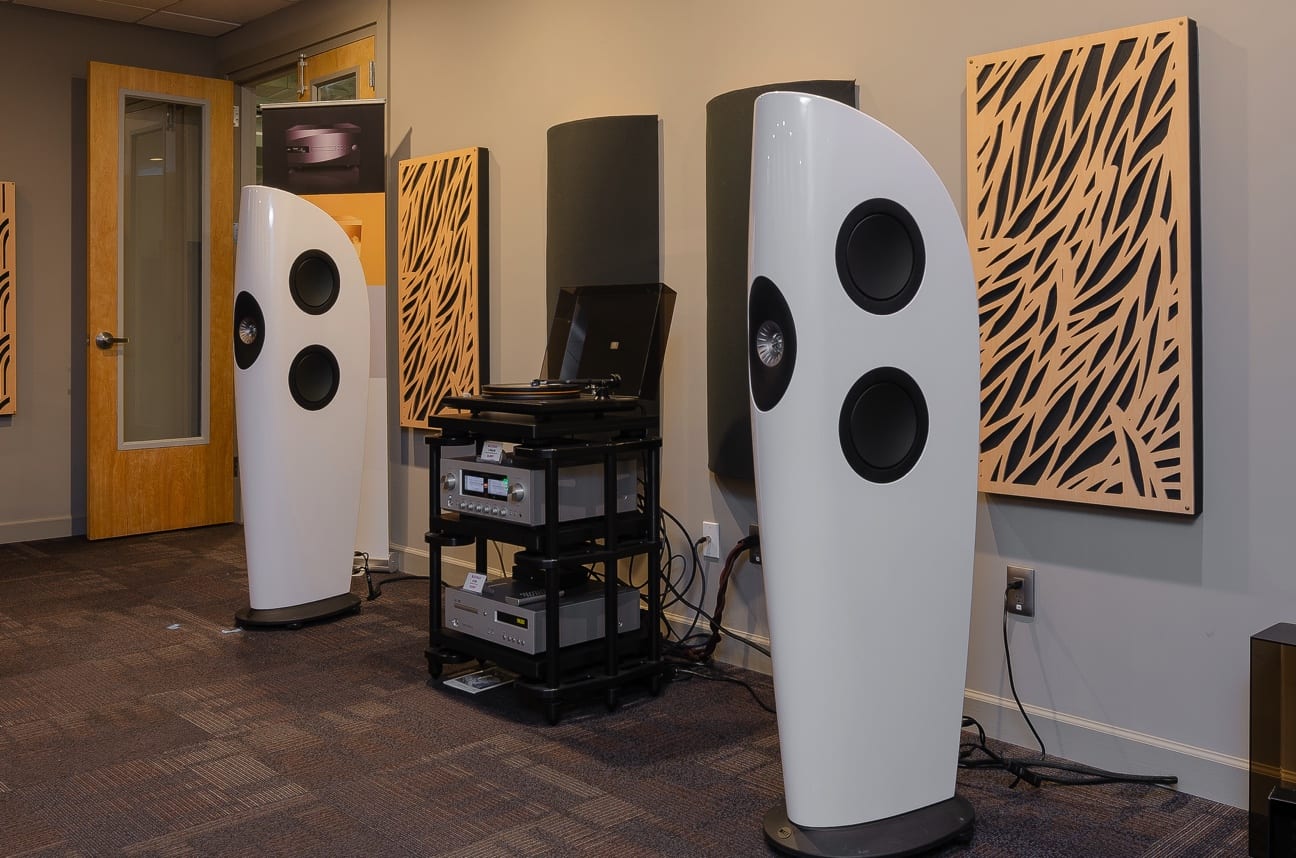
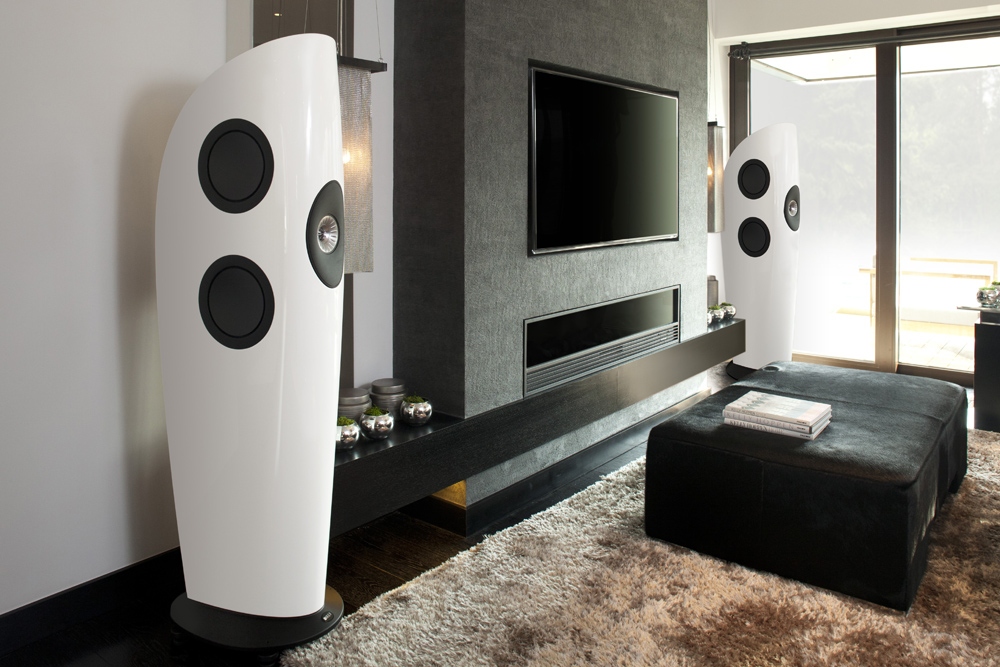
It's interesting stuff though!
For instance, I've heard the Kef Blades and the Kef LS50 back-to-back, many times. I don't think that the Blades image better than the LS50, and if I had to pick one, I'd probably give the "imaging" edge to the LS50. The Blade absolutely destroys the LS50 when it comes to dynamics, but the LS50 is every bit as competitive, above 200Hz or so.
If this experiment of mine is any indication, the (possible) superiority of the LS50's imaging may be that the LS50 has more "air" around the cabinet, compared to the Kef Blade.
- Home
- Loudspeakers
- Multi-Way
- Improve Your Existing Speakers for Twenty Bucks
